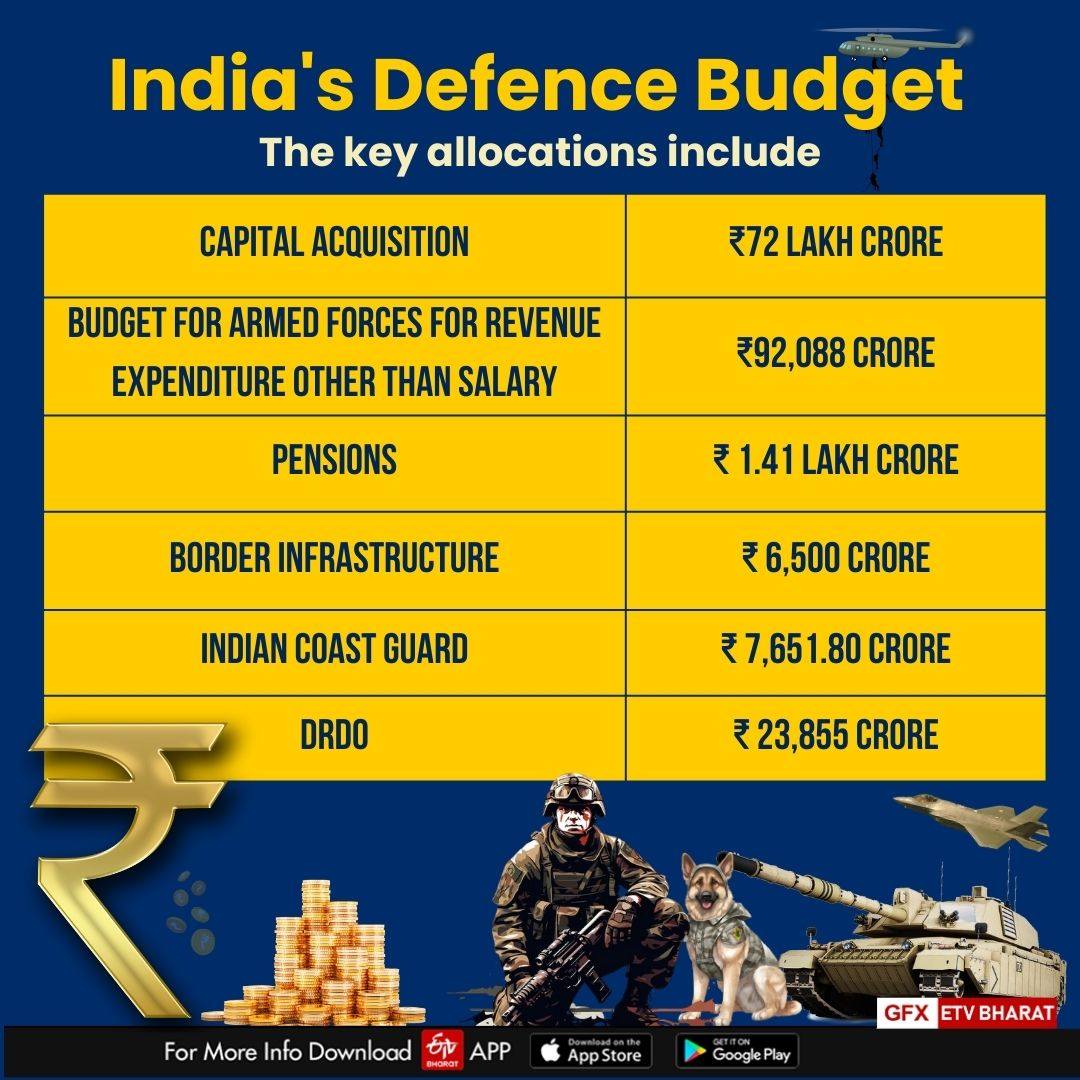India's defence budget allocation has gradually increased in the course of four years: ₹4.71 lakh crore (2020), ₹4.78 lakh crore (2021), ₹ 5.25 lakh crore (2022) and ₹5.94 lakh crore (2023). The interim budget for 2024-25 on February 1 allocated ₹6, 21,540.85 crore to the defence sector for 2024-25, a meek hike from last year’s allocation, 4.7 per cent higher than the allocation for 2023-24.
Key Allocations in Defence Budget
The key allocations include capital acquisition (₹72 lakh crore); budget for armed forces for revenue expenditure other than salary (₹92,088 crore); pensions (₹1.41 lakh crore); border infrastructure (₹6,500 crore); Indian Coast Guard (₹7,651.80 crore); and DRDO (₹ 23,855 crore).
As the union budget is expected to be an extension of the interim budget, instead of these allocations, there are higher expectations that the defence budget is likely to get an enhancement of 7 to 9% in the upcoming budget going to be presented on Tuesday. Defence specialists and industry has been waiting on allocation for 'Make in India', defence production and exports, modernisation, research and development (R&D) and more eagerly on the Agnipath scheme amid its criticism.

Expectations of Indian Armed Forces:
Indian armed forces look forward for at least 25% of the government’s total expenditure for defence in the budget to be announced on Tuesday because it is indispensable to enhance defence capabilities and readiness along the border areas with China and Pakistan. Despite the fact that Pakistan has not been a major worry, deployment of a large number of troops on the border with Pakistan is standard spending. On the contrary, the apprehensions with China certainly need extensive investments in infrastructure and emergency purchases of new equipment.
To compete with China’s infrastructure, a special grant for the Border Roads Organisation is expected for the construction of roads, bridges and tunnels close to borders and also to incorporate a separate provision for purchasing arms and ammunition is anticipated in the approaching budget. In the Interim budget (2024-25), the allotted $75 billion is not adequate to counter China, whereas China’s defence budget for 2024 will be around $231.4 billion. Even though the Indian economy has limitations compared to China, India is obliged to fill the inadequate allocation by an impressive rise in defence spending.

Role of 'Make in India'
The 'Athmanirbharata' ('Make in India') plan has been playing a key role in growing the share of the defence capital procurement budget apportioned for domestic procurement. According to Pushan Sharma of CRISIL, this has mounted from 68% in 2022-23 to 75% in 2025, with 25% reserved for the private sector.
In 2024, India's defence production reached ₹1,26,887 crore, with private sector companies contributing ₹26,506 crore, which is 21% of the total production. The goal is to reach ₹3, 00,000 crore by 2028-29. Over the last three financial years, the Ministry of Defence (MoD) signed 122 contracts to complete the defence projects. Notably, 100 of these contracts, accounting for 87% of the total contract value, were signed with Indian merchants. In this context, beyond the annual budget, in a momentous march towards achieving self-reliance in defence, on July 16 MoD notified the fifth 'Positive Indigenisation List' comprising 346 strategically important items, endeavours to curtail imports and boost domestic production for Defence Public Sector Undertakings.
India's defence production in 2023-24 was ₹ 74,739 crore, compared to ₹ 1.09 trillion in 2022-2023. Defence exports had touched a record ₹ 21,083 crore in 2023-24. In February, Defence Minister Rajnath Singh had said that India’s annual defence production was expected to touch ₹ 3 trillion by 2028-29, while exports of military hardware could reach ₹ 50,000 crore.

Private companies accounted for a larger share of defence production in 2023-24 which was more than witnessed in the preceding eight years. On this basis, ahead of the current budget, the industry has been waiting for any hopeful measures that may be taken in the forthcoming budget because India's defence capital acquisition budget needs to grow 25% annually over the next five years, starting with the budget for 2024-25, to achieve the ambitious annual defence production target of ₹ 3 trillion by 2028-29.
An expectation of the increased share in the defence budget supports and strengthens modernisation efforts to fill up vital capability gaps through the acquisition of advanced technology and weapons systems, procurement of additional aircraft, upgrading of Su-30 fleet, final operation clearance for projects like LCA-Tejas Mk1 jet configuration, initiatives of army, navy, air force and notably investments in indigenous defence projects under 'Make in India'.
In addition, it is time to allot more funds to materialise a globally competitive Indian aerospace industry through 'Make in India' to develop or obtain leading-edge aerospace technology through technology transfer for new aircrafts including engine technology which was neglected by R&D until now.
Expectations of Shipbuilding Sector
In the meantime, the shipbuilding sector has also expectations that the defence budget will boost India's ambition to grow to be a top 10 shipbuilder as stated by the Maritime India Vision 2030 and move into the top five by 2047 as desired by the Maritime Amrit Kaal Vision. Moreover, ahead of 2024, there is an expectation by industrialists for the privatisation of some DRDO labs and a 10% increase in R&D for technological expansions, and the indigenisation of defence gear and tools together with investments in cutting-edge technologies, such as artificial intelligence, cyber warfare potential, and space-based advantages.
The Agnipath Scheme
The Agnipath scheme, aimed at reducing India's defence salary and pension bills, is under considerable condemnation from diverse sections including Congress and its allies, some BJP allies and some military veterans. According to them the scheme, proposed to cut pension expenses, may possibly compromise combat preparedness in the course of intensifying threats with China and Pakistan.
Due to such vast criticism of the scheme, Dr Amit Singh, of the Special Center for National Security Studies, at the JNU suggests that "the government could revise the policy by adopting the Indian Army's proposals for significant reforms comprising extending service tenure from four to eight years and raising the induction age for technical services to 23 years."
However, the rising share of personnel cost has come at the expense of modernisation efforts, support systems, and maintenance of the equipment and resources to ensure the readiness of the armed forces. A study by the Observer Research Foundation (ORF) noted that "one Agniveer costs the government ₹ 1.75 lakh less annually compared to a full-time recruit. For a batch of 60,000 Agniveers, the total savings on salaries would amount to ₹ 1,054 crore."
After the implementation of the scheme in September 2022, the allocation of essential capital expenditure increased from ₹ 1.43 trillion i.e. 24.9% of the total in 2022-23 to ₹ 1.72 trillion i.e. 27.7% in 2024-25. At this backdrop, defence experts have been worrying about any change in the scheme in the defence budget due to criticism, set to be unveiled on July 23, may affect modernisation efforts.
To tackle the rapidly changing geo-political developments including China’s conflicts with the littorals of the South China Sea, unpredictable borders, modernisation imperatives, and promoting investments in the defence sector, India must increase the defence budget extensively in a way that balances the ambitions of common man aligning with modern military needs.
Definitely, the upcoming budget statement on July 23 will also project a continued upward path in defence spending with a focus on two objectives of promoting self-reliance and exports, on top to achieve the goal of becoming a 'Vikasit Bharat' by 2047.
(Disclaimer: The opinions expressed in this article are those of the writer. The facts and opinions expressed here do not reflect the views of ETV Bharat)



